Muthanga Wildlife Sanctuary – Wayanad captivate thousands of travellers every year with wonderful lush green forest that offers delightful ambience and experiences memorable for years as well as this is the second largest wildlife sanctuary in Kerala which is a home to many varieties of birds and animals. Furthermore, Muthanga forest consists of tropical evergreen forests, bamboos and plantations.
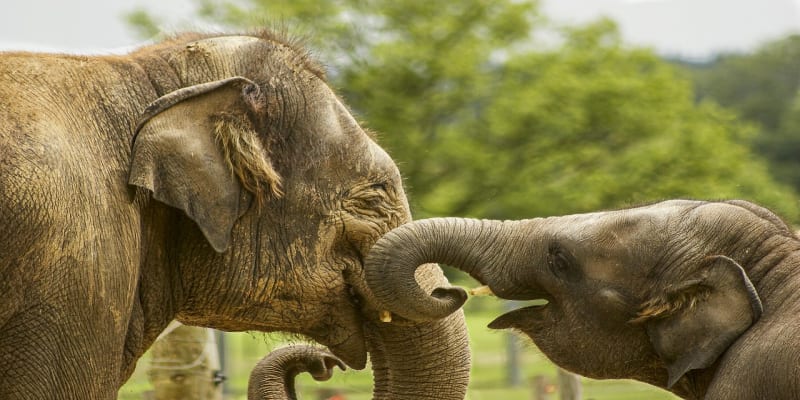
Muthanga Wildlife Sanctuary
Wildlife sanctuary in Muthanga has been established for more than 45 years now , from then the government has declared many Kerala forests as protected land. It is nestled in the centre of a 300-square-kilometer forest and is part of the Nilgiri Biosphere, making it home to a diverse range of indigenous tribal communities. Furthermore, the administration places a strong emphasis on scientific conservation while also taking into account the general way of life of the tribals and others who live in and near the forest. The Sanctuary is a Project Elephant site because of its high population of pachyderms. The Muthanga Wildlife Sanctuary in Wayanad, for example, is roughly 97 kilometres from Kozhikode town.
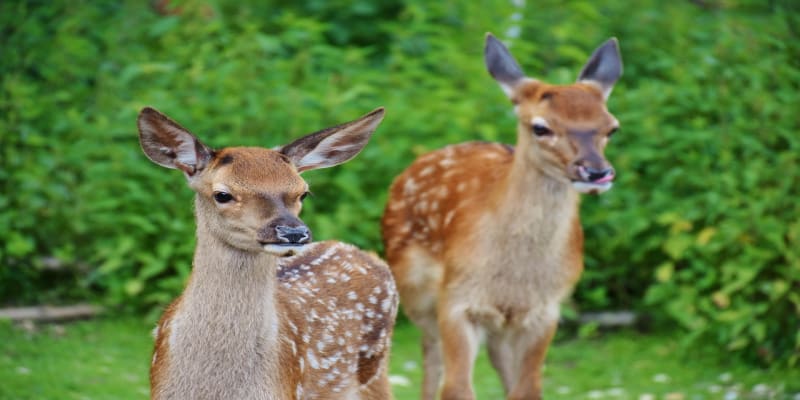
Muthanga Wildlife Safari
Muthanga Wildlife Safari along the road to Wildlife Sanctuary and further offers chances to watch roaming animals like Deer. Elephants roam freely here and tigers can be spot occasionally. Various species of deer, monkeys, and birds also live here. Moreover You will be able to spot tuskers, creepers, colourful birdies & butterflies. A wide variety of species like the Dholes, Jackals, Cheetahs, and Gaurs can be seen during the Jeep Safari. In addition the sanctuary is a home to other animals like Bisons, Panthers, Elephants, Wild Cats, and more.
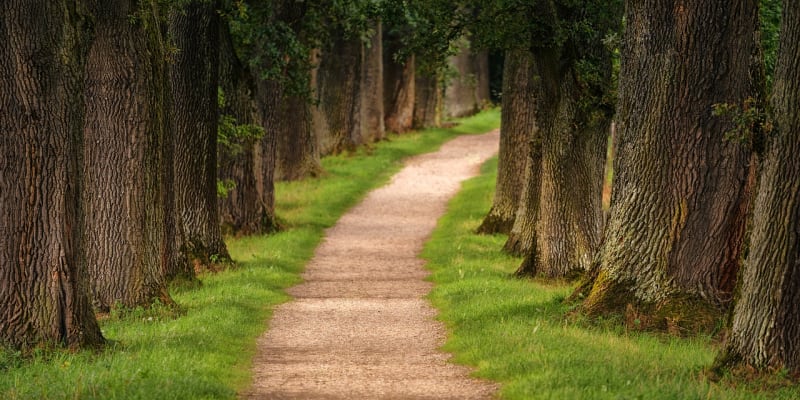
The Jeep Safari
Because visitors are limited to the outside tourism zone, it provides a unique viewpoint on how we must work to preserve these natural marvels. The forest department conducts a two-hour jeep safari in the tourist zone of the rainforest as part of Wayanad’s ecotourism programme. With the assistance of a driver and an expert guide. In the same vein , you would not know how time flies as you go through the evergreen forests, bamboos and plantations. On the other hand, elephants and gaurs are the usual sight in the trail, however the sight of big cats comes as a bonanza.
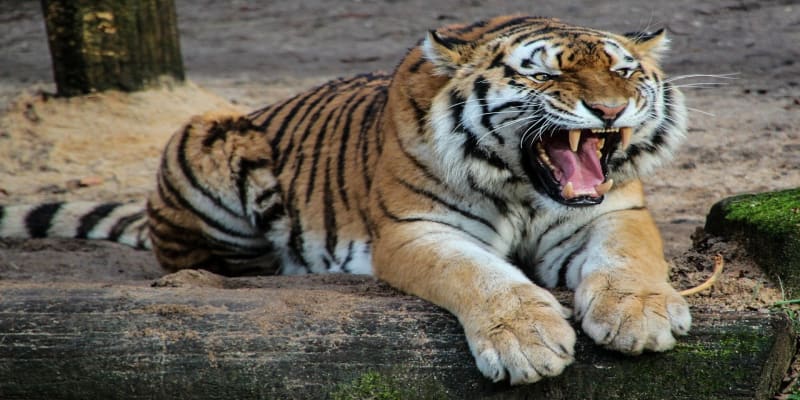
The Wayanad wildlife sanctuary is divided into four ranges: Sulthan Bathery, Kurichyad, Muthanga, and Tholpetty. Muthanga and Tholpetty are the most popular tourist destinations. Although they are separated by plantations, the Wayanad wildlife sanctuary contains two eco-tourism centres. The Jeep safaris are also done in the morning and evening, when animal activity in the tourism zone is at its peak. The Jeep Safari starts at 7:00 a.m., with just 40 jeeps allowed in the morning and only 20 jeeps allowed in the evening, with a forest ranger assigned to every fifth Jeep. Everything gets packed up quickly, and if you arrive late, you can miss it, so try to get there by 6.30 a.m., or even earlier if possible.
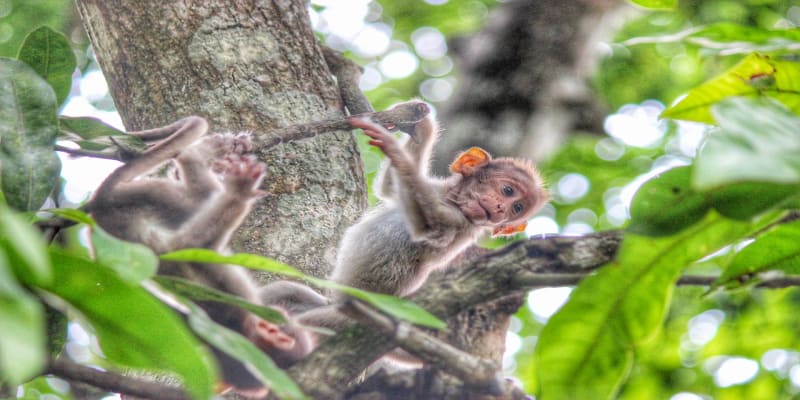
- Location : Muthanga Wildlife Sanctuary, Muthanga
- Timing: 07.00 AM to 10.00 Am (40 Jeeps are allowed) | 03.00 PM to 05.00 PM (20 Jeeps are allowed)
- Entry Fee: Entry Fee Details as follows:
- Adults: 110 per head
- Children: 40 per head
- Foreigners: 300 per head
- Still Camera: Rs 38
- Video Camera: Rs 225
- Parking fee details
- Light vehicles: Rs 75
- Buses/ Heavy vehicles: Rs 150
It is better to have a guide with you as they know the routes well and have a sharp eye for sightings and can also access bird and animal calls. Guides cost will be INR 100. The most popular way of exploring Wayanad Wildlife Sanctuary is by taking the jeep safari. This comes at a cost of INR 300. The jeeps here are not roofless as in other national parks, though. Most importantly total time permitted inside the wildlife sanctuary will be 2 hours only.
Things to carry
- Valid ID proof
- Mosquito repellent
- Water bottles
- Sunglasses
- Sun cream
- Camera
- Hat
Things to do at Wildlife Sanctuary at Muthanga
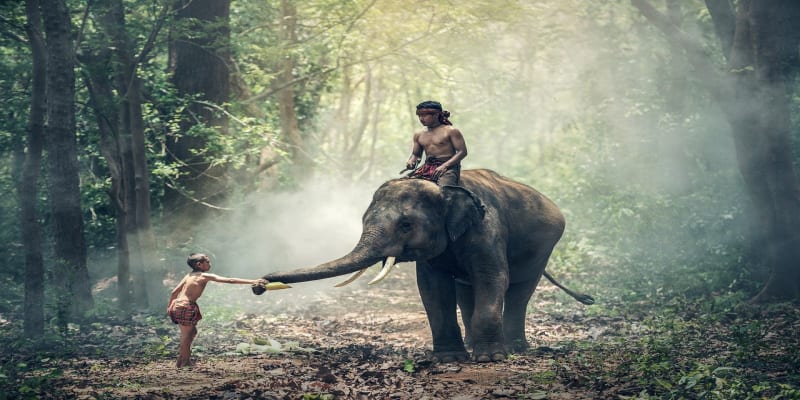
1. Would you like to go for an elephant ride? Yes it is possible. For which you should have a a special permission from the Wildlife Warden or concerned person from Wildlife Sanctuary .
2. Interested in Hiking ? A walking tour inside the wildlife sanctuary is an excellent idea right? You will need to ensure that you are comfortable enough to cover approximately 12 km of distance inside on foot. You can carry enough water bottles to manage your thirst and a good pair of shoes to protect your Foot.
3. Have you ever visited an elephant training camp? To see how this works, you can go to an elephant training camp. Most significantly, wildlife Sanctuary – Muthanga runs a specific elephant camp that serves as a training facility for juvenile elephants before they go wild. Kumki is the name given to these well-trained elephants. This elephant training programme can even persuade wild elephants not to attack humans if they become disoriented and wander into human area.
4. Carry a pair of binoculars, a notebook, and a pen to keep track of all your sightings as well as the names of each bird. Yes, if you enjoy birds, take a birding trip with expert birders and a naturalist who can assist you in spotting the exquisite avifauna that make this nature refuge home.
5. If you’re travelling with a group, a jeep safari is a good option because you won’t have to walk alone and you’ll be able to make many laps of the jungle in search of elusive tigers and other exotic animals.
What is interesting about Muthanga Wildlife sanctuary
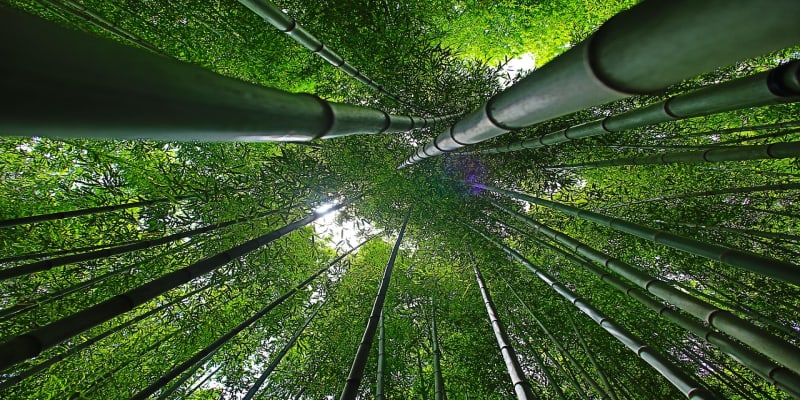
1. Second largest animal sanctuary in the state of Kerala.
2. This place strikes the ideal balance between protecting tribal communities and conserving wildlife, and it was previously the battleground for Pazhassi Raja, who fought British colonialists and the East India Company in 1805.
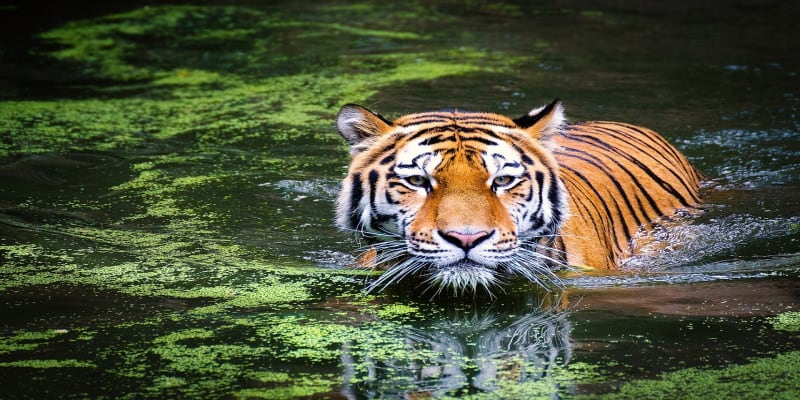

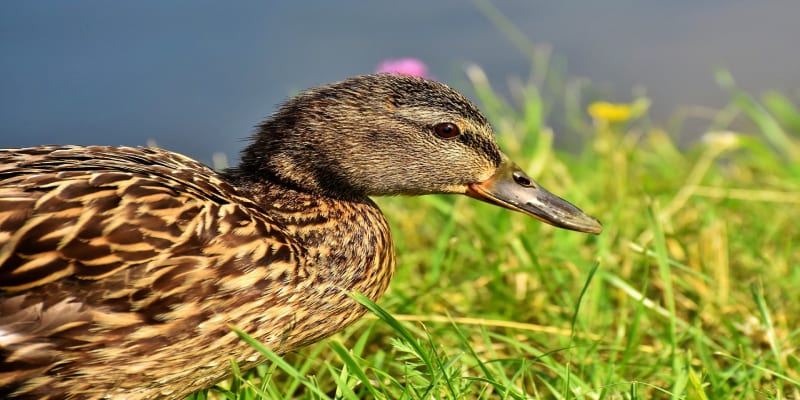
3. The forest types here ranges from West coast semi-evergreen forests to South Indian Moist Deciduous forests, including trees such as Grewelia, eucalyptus etc. The moist deciduous forests typically have trees and herbs such as bamboos, karimaruthi, mazhukanjiram, rosewood, venteak, vengal etc. The semi-evergreen forests have their own lustrous plants like Veteria indica, Termianalia paniculata, Lagerstroemia and Lanceolata.
4. This sanctuary is preserved with 45 species of mammals, 203 species of birds including the Malabar Grey Hornbill, peafowl, cuckoos, owls, water ducks, etc., 45 species of reptiles, 30 species of amphibians and 59 species of fishes, including some dangerous ones such as the poisonous African catfish.
6.The Red-headed and White-rumped Vultures, also other vulnerable vulture species, call this home. The number of vultures in the forest has been steadily decreasing, as has the number of vulture nests.
7. Tribes living in these forests include some scheduled adivasis as well.
8. This sanctuary is home to 75 tigers, while the remainder of the state is home to the remaining 101 of the state’s total tiger population of 176.
9. The scent of eucalyptus and coffee plantations fills the air inside the forest.
10. Anti-poaching stations are located throughout the Sanctuary to deter poachers from hunting in the wild for recreational, game meat, or other industrial purposes.
11. The sanctuary’s outside zone is open to the public. Only forest officials and wildlife researchers have access to the inner zone, which has a higher concentration of vegetation and species.
Things to Keep in Mind While Visiting Wildlife Sanctuary – Muthanga
1. Forest reserves, national parks and wildlife sanctuaries require special attention and caution on the part of visitors. You will require a permission from forest authorities before you can enter the Sanctuary.
2. Wear dark and dull tones of clothing and colours that don’t easily stand out, such as savage green, brown, off white, and so on, to prevent disturbing the birds and animals. Avoid wearing bright tints of red, orange,or fluorescent hues.
3. Save yourself from getting sunburnt. Do not forget to apply generous amounts of sun block- SPF 40 or higher and wear a scarf of Safari cap especially on afternoon Safari.
4.Ideally wearing perfumes with sharp notes or even applying moisturizers or hair products with sweet scents not recommended. You can stick to a basic deodorant with musk or citrus notes if you are worried about perspiring too much in the heat.
5. If you want to travel with your children, teach them not to shout or speak loudly when they see an animal or bird. If the animals become excited, finding them becomes more difficult.
6. If available, carry different sets of cameras to get the best clicks from the jeep safaris.
7. Apply mosquito repellent sprays or creams on the exposed body parts to protect yourself.
8. In the wildlife sanctuary, pets are not permitted. As a result, you should leave yours with the resort’s caretaker.
9. Remember to wear your trusty all-terrain shoes and carry plenty of water with you. Keep in mind that the forest is a plastic-free zone. Hence, plastic boxes or bottles will not be allowed.
10. All age groups are allowed but make sure you treat them as per the age group.
11. Avoid consuming heavy food or alcoholic beverages during Jeep Safari.
12. Follow the rules and regulations given by the authorities.
Places to Visit Near Wildlife Sanctuary In Muthanga.
There are a handful of places you can visit once you are done with the Wildlife Sanctuary In Muthanga.
Seetha Devi Temple
At a distance of 32 Kms from Kalpetta and 25 Kms from Sulthan Bathery, Seetha Lava Kusha Temple is located in Pulpally. This is the only known temple dedicated to Lava and Kusha, the sons of Lord Rama. Only 3.5 km from Wildlife Sanctuary – Muthanga. The Sita Devi idol here is known as -Jadayatha Amma-. It is believed that Lava and Kusha grew up in this place. The original name of this place was Sisumala and later changed to Sasimala. Seetha Devi Temple has a pond in its premises which happens to be the largest in the district of Wayanad. Pulpally is connected by bus service from Kalpetta & Sulthan Bathery.
Kuruva-Island-Wayanad
Also known as Kuruvadweep, this protected river delta is an island which does not have any permanent residents. Surrounded by a group of satellite islands. One of the most beautiful spots in the Wayanad region, Kuruvadweep or Kuruva island is a major tourist hotspot. The one thing that is really striking about this place is the complete silence broken only by faint jungle sounds. A world away from the buzzing city, Kuruvadweep is truly a nature’s gift to all the visitors in this place. The island is quite rich in biodiversity, thanks to its avifauna, herbs and orchids.
- Entry Fee : The entry fee for visiting Kuruvadweep Island is Rs 80 per person for Indian nationals and Rs 150 per head for foreign tourists by Kerala Forest department for which counter closes at 4:30 pm.
- Timing : All days of the week – 8:00 AM – 5:00 PM
- Activity Duration : 1 to 2 hours
- How to Reach : It is Located on the Kabini river, about 17 km from Manathavady. You can take a cab to reach at this serene place.
3. Valmeekam Tribal Museum
- Entry Fee: The entry fee to Valmeekam Tribal Museum is only INR 30 per head
- Timings : It is open from 9 AM to 6 PM on all days of the week
- How to Reach : Valmeekam Art Gallery and Museum is very close to Kuruva Island. It is 35 km from Kalpetta and 45 km from Bathery. The closest big towns are Calicut (Kozhikode – 115 km) and Mysore (105 km).
- Valmeekam Art Gallery and Museum – Near Kuruva Island, P.O.Bavali, Mananthavady, Wayanad, Kerala, India
4. Begur Reserve Forest

A 2-hour drive from Muthanga Sanctuary will bring you to the Begur Reserve Forest in Kalpetta. The Begur Wildlife Sanctuary is one among the best to explore in Wayanad district. The lush greenery and rare faunal species make it a must visit destination. Wildlife lovers can spot bison, elephants, civets, bears, panthers, spotted deer, monkeys, wild boars, jungle cats, wild dogs and more.
How to Reach : Nearest railway station: Thalassery in Kannur district is about 80 km from Mananthavady, The Nearest airport is Calicut International Airport which is about 106 km.
5. Thrissilery Shiva Temple
Located approximately 60 km away from Wayanad Wildlife Sanctuary, this Hindu temple is on the Mananthavady-Mysore Highway. A popular pilgrim centre in Wayanad, the Thrissilery Shiva Temple is one of the oldest temples in Kerala. you are going to be here around March and April, do not miss the annual festival which follows the month of Meenam from the Malayalam calendar. You can also see a small shrine of Jala Durga, located in a water body that originates from the Papanashini River near Thirunelli. The winter month of Thulam which falls roughly between October and November, sees the celebration of another festival called Puthari.
- Timings : Thrissilery Shiva Temple is open on all days from 6:30 AM to 10 AM and again from 5 PM to 6:30 PM
- How to reach : The temple is located on the Mananthavady-Mysore Highway in Wayanad district. It is 8km from Mananthavady and 37km from Kalpetta. Both these locations are well-connected by road to various cities of Kerala, such as Calicut, Kannur, Kozhikode and Kottayam. The nearest railway station is at Mysore. From Thirunelli the temple is accessible through auto rickshaws and taxis.
7. Muneeswaran Kunnu Viewpoint
Few of hours from the wildlife sanctuary is this trekkers’ favourite viewpoint. Muneeswaran Kunnu Viewpoint is best viewed on foot because trekking and camping are recommended here over touristy sightseeing. There is a restriction to how many people can stay on top, so if you want to pitch your tent there, check with the locals beforehand. The view from the top of the hill is breathtaking.
- Entry Fee : You can take your car till the entrance where a fee of INR 40 is charged per head
7. Muneeswaran Temple
Muneeswan kovil is a beautiful place, located 45 kilometres distant in Thalapuzha in the Begur Range of North Wayanad division. This Hindu temple in Thalapuzzha is a pit stop to the Muneeswaran Kunnu Viewpoint, which requires two more hill crossings. The Muneeswaran Temple atop the hill gives the area its name. The temple was supposed to be built by descendants of Tamil labourers recruited by the British to work on tea plantations at the turn of the century.
- Entry Fee : Muneeswaran temple is charged an entry fee of Rs 30.00 by the Makkimala Adivasi VSS who is authorized to run this.
8. Thirunelli Temple
This historic temple sits at an altitude of 900 metres above sea level, on the Brahmagiri Hill. Thirunelli is a one-of-a-kind location where one can feel nature’s oneness with divine energies. Thus it becomes an ideal spot for pilgrimage as well as an idyllic location for enjoying the nature’s bounties. Sunrise on the Brahamagiri at the back drop of Thirunelli temple is an enthralling sight. This temple, as proven by the current age, came to the first place with the head priests to offer the Prasadam to the Lord and is believed that it will be taken or accepted by the Lord Brahma. Hence, when the temple is closed in the night, it will be offered and when it gets opened in the early morning, the prasadam would not be there.
Opening
- Pilgrims can visit the temple both in morning and evening.
- It is open from 5.30 am to 12.00 pm in the morning.
- The aarti is magical. It takes places at 11.30 am.
- At evening the temple is open from 5.30 pm to 8.00 pm.
Dress Code at Thirunelli Temple
Devotees generally come in traditional wear. Men need to enter the temple without shirts. Leather apparels and items cannot be brought into the temple complex. Worshippers need to wear dhoti which is available at the priest office.
Festivals celebrated at Thirunelli Temple
Puthari, Chuttuvilakku, Navarathri, Shivarathri and Sreekrishnajayanthi are the major festivals of the temple.
How to Reach: Road, Rail and Air
The place is easily accessible as it is a tourist hotspot. If you are coming from outside Wayanad, you can come from Calicut. The route from Calicut passes three cities, which are, Thamarasserry, Kalpetta and Mananthavady.
- By Air: The Calicut International Airport is the nearest airport to the Thirunelli. This airport is at 161 kms from the Thirunelli Temple. Tourists can book cars directly to the temple. You can also use the Bangalore route to reach Thirunelli Temple. After reaching the Bangalore International Airport, tourists need to come to Mysore. From here proceed to Thirunelli via Hunsur and Nagarhole. The temple lies at 280 kms from Bangalore airport and 121 kms from Mysore.
- By Rail: The nearest railhead to the temple is also at Calicut. From the railway station, tourists first need to reach Mananthavady and then to Thirunelli. There are many taxi and bus available from the station. The distance from Calicut to Mananthavady is 137 km if you are coming through the Koyileri – Mananthavady road. You can also take the 4th mile – Mananthavady road to reach the temple, but the distance is more; 141 kms. The next nearest railway station to the temple is Mysore railway station. This is at 121 kms from the shrine.
- By Road: You can enjoy the most if you are travelling to Thirunelli Temple via road. There are various ways in which you can reach the Thirunelli Temple via roadways.
- From Kerala- Karnataka Border: From this place you need to ride till the Mananthavady road. After driving for almost 7.4 kms you will reach the Thetturoad Junction. Take a U-turn to reach the temple, which is 13 kms from the junction.
9. Irupu Falls
The fresh water from these falls, also known as Lakshmana Tirtha Falls, is a source of supplies for a tributary named Lakshmana Tirtha River, which flows into the famous Cauvery River. The Irupu or Iruppu Falls, located on the highway to Nagarhole, are a beautiful group of flowing waterfalls in the Brahmagiri Range of mountains. Many Hindu followers think that bathing in the Iruppu Falls will wash away their sins. As a result, it is usual to see people bathing in these waterfalls, particularly on the Hindu festival of Shivatratri.
- Best time to visit : You can make a visit to this wildlife sanctuary from June to October. Frequent buses are available to reach this destination. The other destinations near to Wayanad wildlife sanctuary are Bandipur National park, Mudumalai Elephant Park and Nagarhole Willife Sanctuary.
- How to reach :
- Nearest railway station: Kozhikode, about 97 km by road from Sulthan Bathery
- Nearest airport: Calicut International Airport, Kozhikode, nearly 120 km from Sulthan Bathery
- Located around 16 km away from Sulthan Bathery, the Wayanad Wildlife Sanctuary, popularly known as Muthanga Wildlife Sanctuary is a rainforest wich connects Nagarhole and Bandipur parks in Karnataka and Mudumalai in Tamil Nadu. Spread over an area of 345 sq km. It is about 97 kms from Kozhikode town. You can reach easily by Private Transport.
Best 5 Forest Resorts Wayanad
1. VOYE HOMES Wildside Jungle Retreat
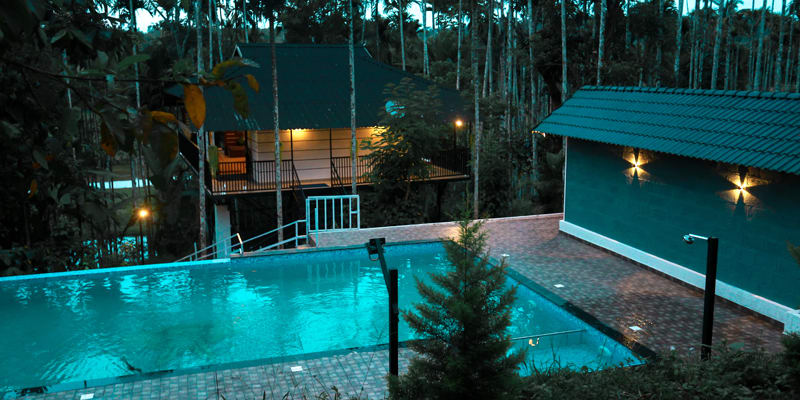
The Plantation Resort VOYE HOMES Wildside Jungle Retreat Wayanad is located in Sultan Bathery, Wayanad, Kerala. This is usually a plantation retreat near the Muthanga forest valley. This resort sits on the borders of the wildness, surrounded by deciduous damp woodland and paddy fields. The Muthanga forest valley is home to a diverse range of trees and plants. With the backdrops of stunning countryside, woodland valleys, lochs, and animals, this is an ideal setting for a fantastic holiday.
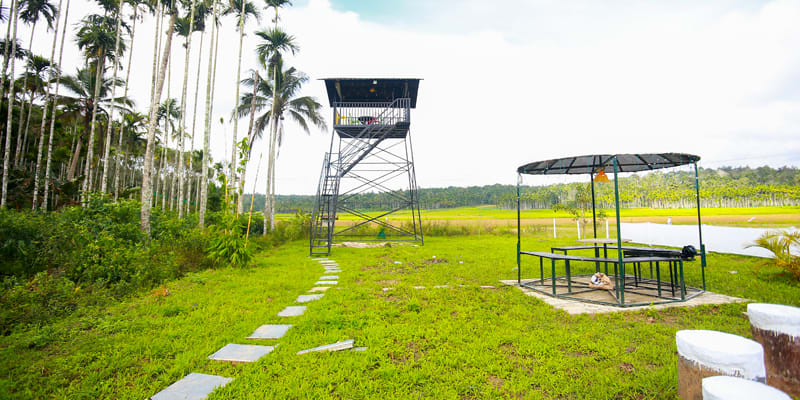
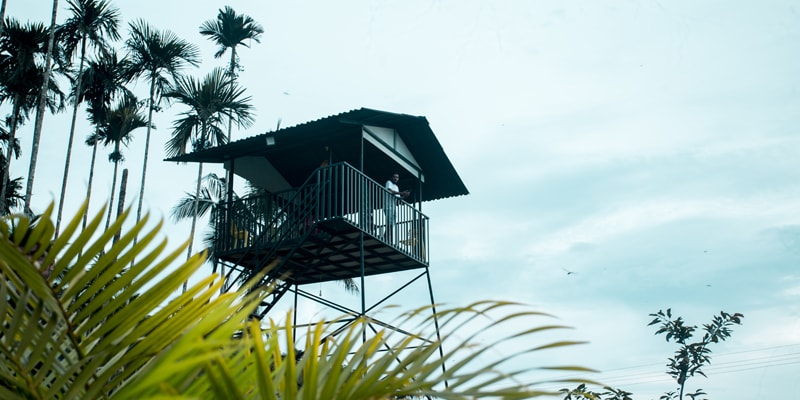
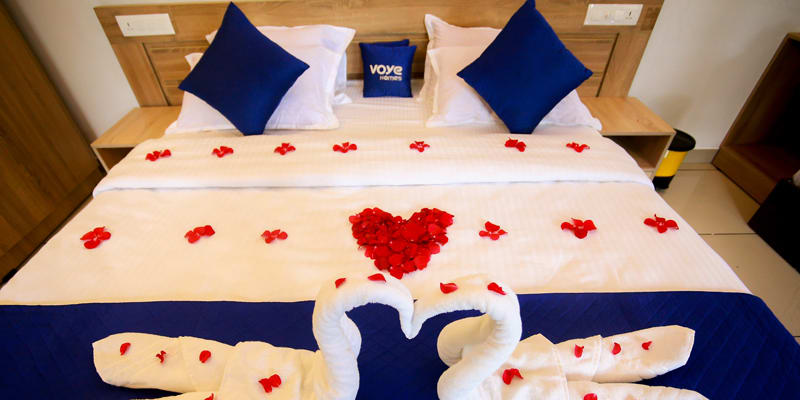
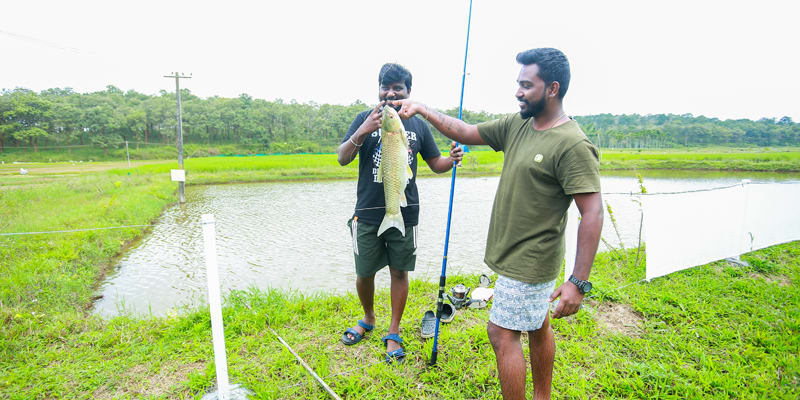
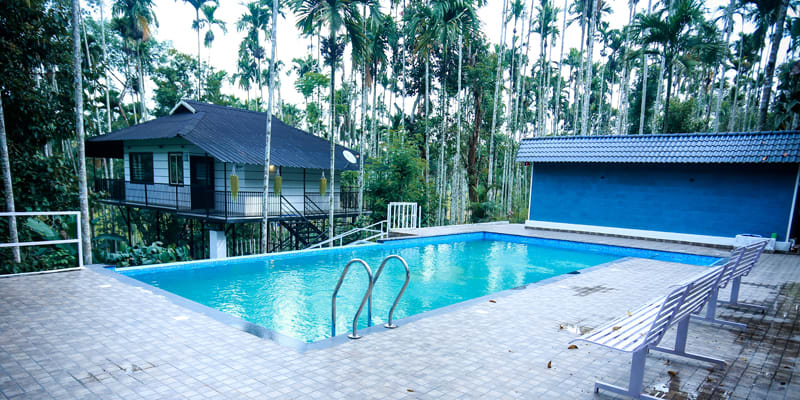
A fantastic location that provides you with ultimate natural retreats to treasure and take home. Prepare to be amazed by the plantation resort’s beautiful world of wildlife, which is set near the Muthanga forest valley, around 13 kilometres from Sultan Bathery, Wayanad, amidst the evergreen forest, where you may enjoy jungle luxury and listen to elephants roar.
Wildside Wayanad has 3 individual premium cottages (2 double room and 1 single room) and a Heritage villa with 2 bedrooms. Another significant feature of the resort rooms is the built-in soothing music system, which will help to make your holiday memorable and enjoyable. Wildside stands out for providing the best in terms of accommodation, recreational activities, food, and other aspects. We provide you with an unusual ambiance complete with a heavenly experience.
Highlights
- Infinity swimming pool
- Individual private cottages.
- Fishing
- In house restuarant.
- Watch tower
- Kids pool
- Campfire & chicken/fish barbeque
- Plantation Walk
- Muthanga wildlife jeep safari.
- Premium rooms & heritage rooms
Activities Available
- Infinity Swimming Pool
- Campfire & Chicken, Fish Barbeque
- Muthanga Wildlife Jeep Safari
- Fishing
- Games
- Watch Tower
- Nature Walk
- Tribal Life
- Kids Pool
Near By Places To Explore
- Muthanga Forest & Wildlife Sanctuary (10.00 km)
- Chethalayam Waterfalls (09.00 km)
- Kuruva Island (43.00 km)
- Thirunelli Temple (55.00 km)
- 900kandi (50.00 km)
- Sulthan Batheri (06.00 km)
Respect wildlife/Tribal life. Never ever disturb their daily habitat.
Interested? , Visit voyehomes for more info…
2.Wild Tusker Resort Muthanga
Muthanga Wild Tusker Resort is situated in the most beautiful location of Wayanad making it a perfect choice for all travelers. Guests can visit wonderful places like Muthanga Wildlife sanctuary, Chembra Peak, Banasura Dam and much more.
- How to Reach– The nearest forms of transportation in this location are Kozhikode Railway Station, Kalpetta New Bus Stand, and Calicut International Airport, which guests can use to get to the hotel.
- Room Amenities: Wooden cottages provided to the travellers make their stay memorable. In addition to that, well-maintained and spacious rooms are available at the property which is complete with modern amenities. They also have cable television, attached bathrooms, basic toiletries and hot and cold water supply.
- Hotel Facilities: At the resort, guests are sure to have a vibrant experience that will make their stay memorable. Room service, a front desk, paid Wi-Fi, a jeep safari, and on-site parking are all available to them. At the resort, guests may also enjoy a campfire and BBQ. A doctor on call service is available in the event of an emergency.
- Dining: Travelers can relish their taste buds to scrumptious and mouth-watering delicacies at the in-house restaurant.
3. Vintage Garden Resort
The Resort is a one-of-a-kind and tranquil retreat dedicated to bringing peace and joy to all visitors. Vintage Garden is a place where you may get close to nature. Located hardly 100 meters away from Wayanad Wildlife Sanctuary, the place assures easy access and excellent sightseeing opportunities in and around Wayanad!
Aim to facilitate guests to have a better connect with nature. They have various holiday plans and packages that take you through the heart of Wayanad. We unfold a visit like never before and ensure a trip that can be cherished for a lifetime.
4. Kedara Village
Blessed abundantly with lush green forests and rich in wildlife, Wayanad stands unrivalled in being close to nature. Kedara was built by preserving this nature. The resort’s architecture and surrounds have been meticulously designed to reflect Wayanad’s natural beauty.
The Cave, Safari Tent, Tree Top, Green Villa, Keralite Villa, and honeymoon cottage are among Kedara’s hallmark room types. Each variety promises a unique experience during your visit.Kedara Village Resort gives guests a unique flavour of hospitality that offers world-class refinement while remaining deeply rooted in its local tradition.
FAQ

What is the best time to visit Muthanga Wildlife Sanctuary Wayanad?
The best time to visit the Wildlife Sanctuary in Muthanga, Wayanad is from November to October and during the winter (November-February) season.
In the month of August to February the sanctuary will be open and closed during March and April. The Delightful ambiance of the sanctuary best between the month of October and the end of February.
What are the timings for Muthanga wildlife sanctuary Visit ?
The Muthanga wildlife sanctuary will be open 24 hours a day, although the morning Jeep Safari will run from 7:00 to 10:00 a.m., while the afternoon safari will run from 15:00 to 17:00 p.m. In the morning, only 40 jeeps are allowed, and in the evening, only 20 jeeps are allowed.
Which animals can be seen at Muthanga wildlife sanctuary?
Elephants abound, and tigers are occasionally spotted. During the Muthanga Wildlife Sanctuary Jeep Safari, you’ll be able to see a variety of animals, including Dholes, Jackals, Cheetahs, and Gaurs. Many additional creatures live at the sanctuary, including bisons, panthers, wild cats, and more. It also houses a variety of exotic birds, as well as the rare Royal Bengal Tiger, which tourists can see. Among the 200 species of birds that call this place home, you’ll be able to see peacocks and uncommon owls. Aside from the fauna, this refuge also has some rare medical herbs and plants.
What would be the Jeep safari price in Muthanga wildlife sanctuary?
The price is inclusive of pickup and drop , fuel charges, toll charges, driver and guide, and the parking charges. The price for the Muthanga Wildlife Sanctuary Jeep Safari starts from Rs. 350 per person.
What are the safety precautions need to take During Muthanga Jeep safari?
During the Muthanga wildlife safari, to ensure your safety, you must focus on the instructions from experienced tour guides. They are responsible and will always try to protect you from any harm .They know better about the sanctuary and the animals so need not to worry about the safety.
Is the Jeep safari at Muthanga Wildlife Sanctuary safe?
Yes, the safari through the Muthanga Wildlife Sanctuary is completely safe and secure, and it offers incredible wildlife vistas. The jeep drivers are quite adept and experienced in navigating you through the dense wilderness. You will also be escorted by expert forest department guides who will assure your safety at all times. All you have to do is follow the directions of these knowledgeable Guides.
- Make sure you wear comfortable shoes and clothing. There might be some areas that you will have to travel on foot.
- It is also important to keep yourself hydrated, so don’t forget to carry enough water bottles but do not litter it anywhere.
- Kindly avoid carrying any inflammable materials like cigarettes, lighters, or matchsticks. They could be an inflammatory hazard.
- Make sure that you always adhere to the strict guideline of maximum visiting hours of 2 hours with a tour guide.
- You should also wear a cap to resist yourself from the heat and carry sunscreen lotion and mosquito or insect repellants as required.
Permitting Authority:
Wildlife Warden
Muthanga Wildlife Sanctuary
Sulthan Bathery
Ph: +91 4936 271010
Read Next: A Backpackers Guide to Attappadi, Sholayoor – Camping & Trekking
Munroe Island – The Secret Island In Kerala That You Must Visit
